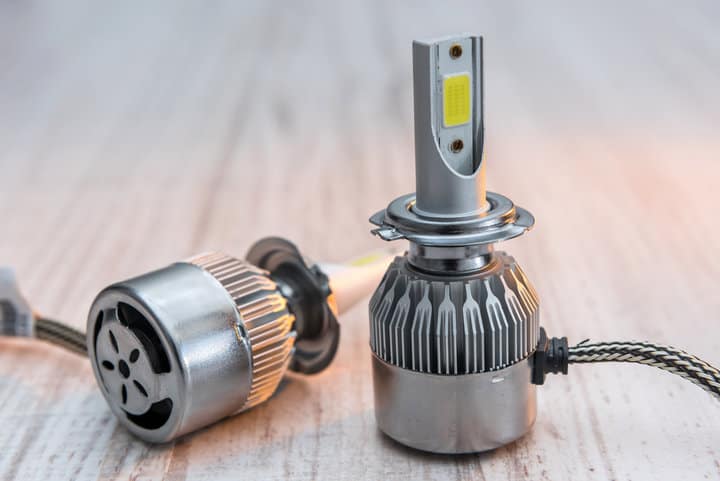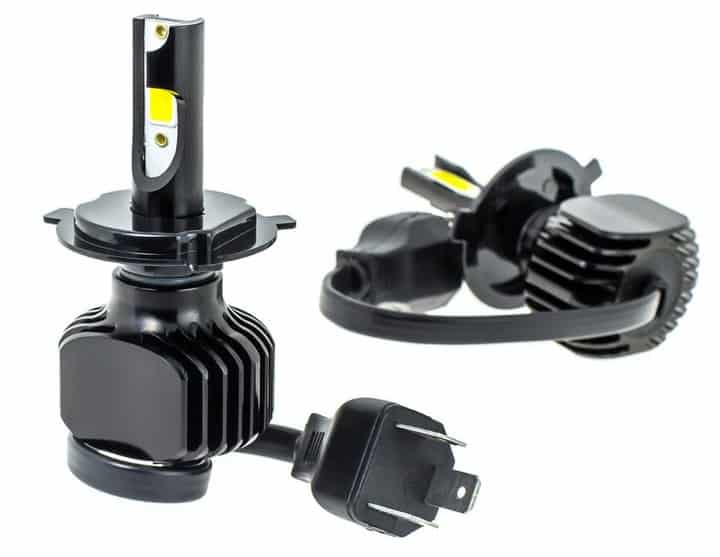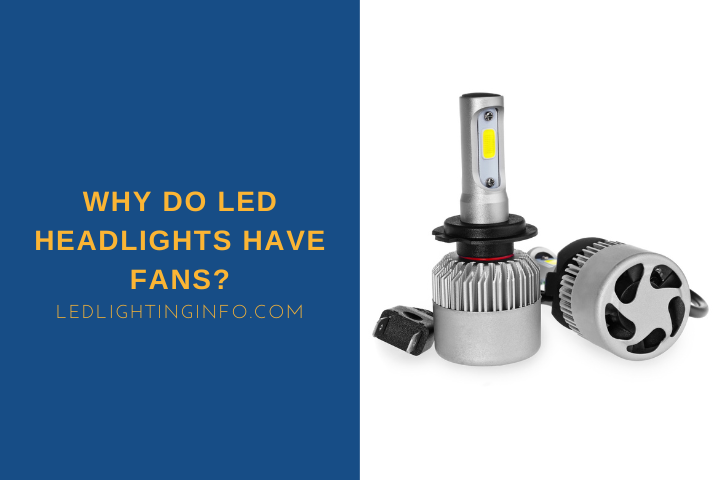LED headlights offer many benefits over older headlights, although they aren’t perfect.
While their lifespan and brightness are often better than other bulb types, they have drawbacks.
One of those is that you might not even be able to fit them in your car.
That’s not because of the bulb size, though – it’s because of the large heatsink that’s needed, and often a cooling fan to keep temperatures low.
So why do LED headlights – that are supposed to run cooler than other bulb types – need a fan when those older ones don’t?
LED headlights often need a fan because the bulb will burn out without active cooling. Incandescent bulbs thrive in heat, but LED bulbs will die quickly if they aren’t kept in optimum, lower temperatures.
To help explain all of this, let’s take a look at:
- How hot LED headlights actually get
- Different types of LED headlight
- Whether fanless LED headlights overheat
How Hot Do LED Headlights Get?

In general, LED bulbs are known for being cooler than other types of light bulbs. That’s because they don’t generate heat to generate light.
Bulbs like halogen headlights use a filament heated to extremely high temperatures to generate light energy.
This is why they’re so inefficient – most energy created is heat, not light.
But with LEDs, light is created when an electrical current passes through a semiconductor. So so much more of the energy created goes into generating light.
But then why do LED headlights get hot? The answer is because of a lack of airflow.
LED lights usually have some form of the heatsink, which helps to drive heat away from the diodes generating lights.
Even at home, those heatsinks have some air nearby to conduct that heat away. But headlights are sealed, and so the heat will build up.
When that happens, you’re putting the LED under much stress, which will massively shorten the lifespan.
Halogen headlights will often reach several hundred degrees (up to 400 celsius/750 Fahrenheit). In comparison, if left uncooled, an LED will max out at around 150-200 celsius (300-400 degrees Fahrenheit).
But an LED can’t withstand those temperatures – they usually can operate at a maximum of 100-125 celsius, with optimal temperatures being much lower.
This is why it’s super-important for them to be cooled.
Halogen bulbs can take those temperatures, but you’re signing a death sentence for your LED headlights if you don’t cool them.
Fan vs Fanless: What Are The Different Types Of LED Headlights?

Now that we’ve established that LED headlights must be cooled to work correctly and for the amount of time you’d expect them to, let’s compare the two types of cooling.
Because only some LED headlights have fans, there are two main options.
LED headlights with fans are referred to as those with active cooling – where a separate device is actively cooling the bulb.
But there are bulbs with passive cooling, which use a braided heatsink to passively draw heat away from the light.
Initially, all LED headlights were fanned – the fanless options are more recent inventions. But which is the better choice?
Fan Headlights
Fan headlights are the original design of LED headlights and have many benefits.
One of their benefits is that they cool the light faster, which means they can operate at a higher temperature.
This allows the lights to work brighter, but this may be a false positive – since you can’t increase the brightness too far without blinding other drivers.
The bulbs also require little maintenance, provided they’re installed correctly.
But there are downsides too – namely that fan headlights can be noisy.
Some noise is acceptable, so expect to hear a little buzzing.
You won’t notice it in most gas-fueled cars while driving, so I wonder if I should consider it a con.
They also consume more power, but we’re talking a tiny amount – these fans are small. So they don’t consume much electricity, a couple of watts.
But the issue becomes if you can’t seal your headlights properly.
Normally they have a dust cap behind them, but the fan will often protrude out as it sits outside the actual headlight.
When you can’t fit a dust cap over the fan, it can become dusty, or impacted by debris.
This amplifies all of the problems – it will work harder to cool the bulb and use more power. It’ll be louder too.
You could try to fit a custom dust cap with more depth, or you may just need to check the fan regularly and clear it out of any dust, so that it keeps working properly.
Fanless Headlights

Fanless headlights are a newer option. They often have a longer lifespan since you aren’t relying on an additional part.
They’re also noiseless – you don’t have to contend with additional buzzing created by the fan.
They don’t need any additional power to work – the heatsink is a non-powered cooling method.
However, the cooling is slower, so the bulb will take longer to cool.
While they generally have longer lifespans than fan headlights, this is balanced a little by the slower cooling.
Plus, you need to monitor the heatsink to ensure it is working correctly and maintain it.
Slim fan headlights, where the dust cap fits over the fan, can be left to their own devices, but you will need to check and service your fanless ones (which you will also have to do with fan headlights where a dust cap won’t fit).
This involves checking there are no obstructions and cleaning them if necessary. Any dust or dirt settling on the heatsink will cause it to heat up faster.
Do Fanless LED Headlights Overheat?

There is one more drawback of the fanless LED headlight, and that’s the potential to overheat.
With a fan headlight, the heat removed from the bulb is expelled, dissipating quickly.
But a fanless headlight relies on that heatsink to draw heat away, where it is then slowly conducted into the surrounding air.
So what happens when the LED goes through consistently higher temperatures? That heatsink may need help to keep up.
The heat will build up over time, and it’ll essentially have a backlog of energy that it needs to dissipate.
This means that LED headlights that don’t have a fan can overheat.
When this happens, expect the LEDs to start having some issues performing as usual – they might flicker or shut down completely.
To help stop this from happening, you need to maintain your heatsinks regularly. Check them for debris and clean them to avoid any build-ups that could prevent heat from dissipating.
If they are still overheating, you may have bought a cheap brand, or they may need to be installed correctly.
Check the installation, and if you’re unsure what you’re doing, see a mechanic in your area with knowledge of LED headlights.
If everything seems fine with the installation, you might just need to replace them with an LED headlight from a reputable brand.
While maintenance is an issue, it’s usually a quick job.
The generally accepted view is that fanless LED headlights will perform better and last longer than those with fans because there is no fan to break – as long as you’ve bought a good quality one.
Final Words
LED bulbs always need some form of heatsink or cooling to ensure they can work at their best, but it’s even more important in the enclosed space of a car’s headlight fixture.
Especially considering the crucial job that headlights do on the road.
Only some LED headlights need a fan. Those without them are still excellent choices, provided they have a good heatsink, and you maintain it regularly.
That extra bit of work will help you enjoy longer-lasting headlights that will be bright and crisp.
Do you have LED headlights? If so, have you chosen the fan or fanless option? I’d love to know what helped you come to that decision.
Claim your 10% discount on the first order with Lasfit

- Replace your dim halogen headlights with bright LED
- LED lighting increases your visibility on the road during the day, and for you in the night
- Select LED lighting that is exactly designed for your car
- Buy with confidence having 45 days money back guarantee
Claim 10% off on your first order over $50, using the promo-code “FIRSTTIME10“!

